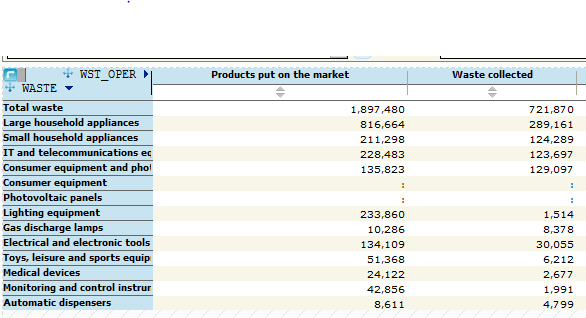Electrical waste is currently one of the fastest-growing waste streams in the European Union. This includes waste electrical and electronic equipment:
- Devices from the PC sector such as laptops, PCs, monitors and printers/copiers
- Consumer electronics equipment (e.g. televisions, radios, video recorders and stereo systems)
- Telecommunication/IT equipment (e.g. mobile phones, (cordless) landline telephones, fax machines)
- Large household appliances such as washing machines and refrigerators
- Small household appliances such as coffee makers, vacuum cleaners, electric toothbrushes, etc.
- Toys, sports/leisure equipment (e.g. video game consoles, bicycle computers and other sports equipment with electronic components)
- Vending machines (coffee machines, cash dispensers, bottle dispensers, etc.)
- Medical equipment
- Electric/electronic tools (e.g. drilling machines, sewing machines, saws, etc.)
Statistics suggest that the volume of electronic waste in the EU is set to increase to up to 12 million tonnes per year by 2020. In Germany alone, more than 700,000 tonnes of waste electrical and electronic equipment were disposed of in 2015. More than 1.5 million tonnes of new equipment came onto the market at the same time.

Table 1: Distribution and disposal of electrical and electronic equipment by category (Germany, 2015), in tonnes,
source: http://appsso.eurostat.ec.europa.eu/nui/submitViewTableAction.do
Unfortunately, the (above all inappropriate) disposal of electrical and electronic waste can have a significant impact on the environment and health.
Waste Electrical and Electronic Equipment – what is the WEEE Directive?
The purpose of the WEEE Directive is to ensure the environmentally friendly disposal and recycling of waste electrical and electronic equipment within Europe. The abbreviation WEEE stands for Waste Electrical and Electronic Equipment. It is supplemented by the RoHS Directive, which concerns restrictions on the use of hazardous substances such as mercury and lead.
What makes the disposal and recycling of electrical waste so problematic?
In addition to valuable raw materials (such as gold), most electrical appliances contain a number of substances that are harmful to health and the environment. The production and disposal of electronic goods are therefore not only associated with an immense consumption of resources – the risks for people and the environment should also not be underestimated. The appropriate and controlled disposal of waste devices is therefore essential. WEEE forms the legal framework in combination with Directive 2002/95/EC on the restriction of the use of certain hazardous substances in electrical and electronic equipment (RoHS).
History and development of the WEEE Directive – did you know?
- February 2003: The EU adopts the first WEEE Directive (Directive 2002/96/EC) with the aim of promoting the proper disposal and recycling of electrical and electronic equipment within the EU: to this end, public collection points are to be set up in each country to enable end consumers to return waste electrical and electronic equipment free of charge.
- December 2008: In order to better counteract the rapid increase in the quantities of electronic waste, the first WEEE Directive is revised once again on the advice of the European Commission.
- August 2012: The revised EU Directive (Directive 2012/19/EU) officially enters into force. It includes, among other things, an extension to the scope of validity, a change in equipment categories and a higher minimum collection rate for waste equipment (45%).
- The new Directive is originally to be ratified in the individual Member States by February 2014. However, only a few countries were actually able to implement the planned changes by this date.
- August 2018: End of the transitional period. Instead of the previous 10 categories, the electrical/electronic equipment affected by WEEE is now divided into the following 6 groups:
- Heat exchangers
- Screens, monitors
- Lighting
- Large appliances
- Small appliances
- Small IT and telecommunications equipment
The RoHS Directive
The aim of the Directive on the restriction of the use of certain hazardous substances in electrical and electronic equipment (RoHS for short) is to reduce the quantity of hazardous substances in electrical and electronic equipment and thus to reduce the environmental impact of equipment disposal. As a result, the following substances have been subject to quantitative restrictions since 2006:
- Lead
- Cadmium
- Hexavalent chromium
- Mercury
And brominated flame retardants. In addition, the 4 plasticisers DEHP, BBP, DBP and DIBP will be completely banned from use from July 2019. They may then no longer be used as components in electrical and electronic equipment. Together with the WEEE Directive, RoHS is intended to better control the distribution of electrical and electronic equipment within the EU and to guarantee its legal disposal and recycling by manufacturers. While the WEEE Directive was implemented in Germany by ElektroG, RoHS is implemented on the basis of the German Electronic Equipment Substances Ordinance (ElektroStoffV).
The WEEE Directive in Germany – the German Electrical and Electronic Equipment Act (ElektroG)
hough the WEEE Directive is valid throughout the EU, the individual Member States are responsible for its practical and substantive implementation. In Germany, the WEEE requirements have been implemented in what is known as the German Electrical and Electronic Equipment Act (ElektroG). The competent authority for national registration and receipt of what is called the WEEE number in Germany is stiftung ear.
